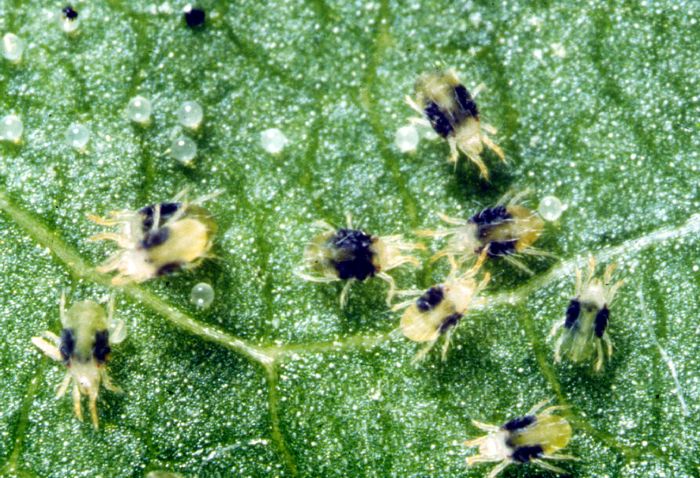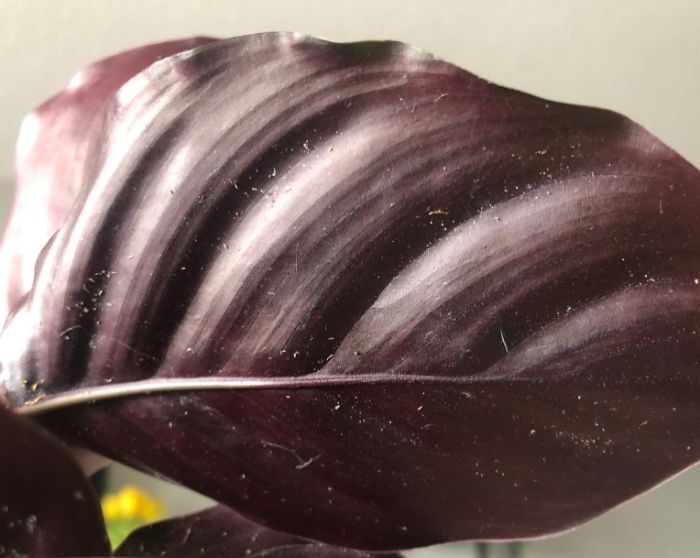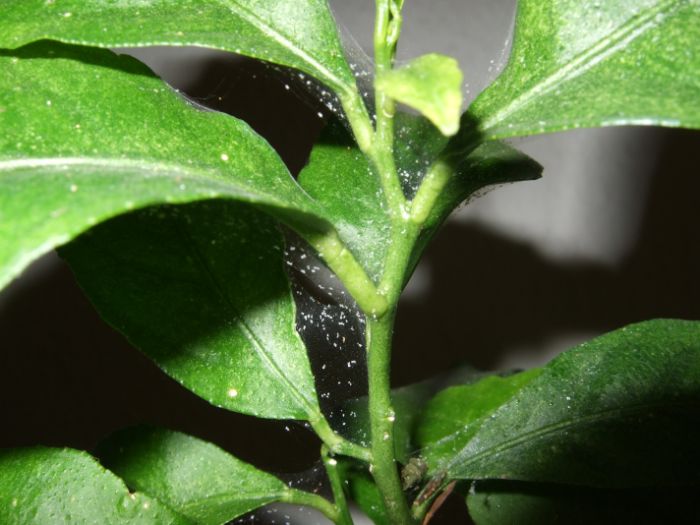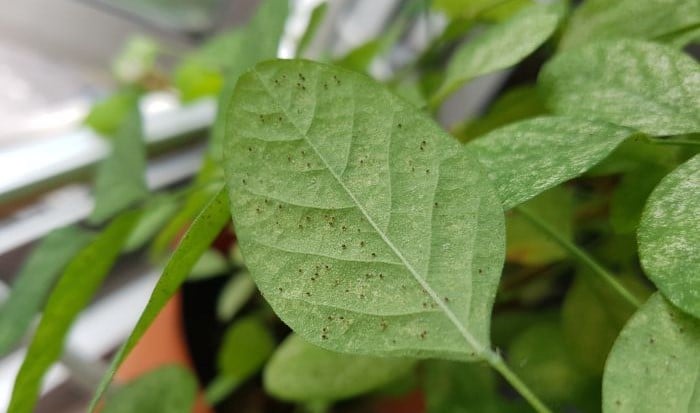Discovering that your beloved house plants have a bout of Spider Mites can be quite distressing, especially if you have never had to deal with these pests before. If you are an indoor plant enthusiast and place value on the health of your plants, you need to know how to get rid of Spider Mites to mitigate the damage that Spider Mites can cause.
How do you get rid of Spider Mites on house plants? You can remove, kill, and deter re-infestation of Spider Mites in your house plants in the following 3 ways:
- Treating the plant with rubbing alcohol.
- Using common dish washing soap & water to clean the plant.
- Using a Botanical Pyrethrin to kill Spider Mites.
With the right technique and products (store bought or homemade), you can free your house plants from the scourge of Spider Mites, quite quickly and easily in fact. You just need to act fast! Read on to find out what Spider Mites are, and how you can defeat them by using the abovementioned techniques.
Spider Mites And How They Damage House Plants – A Brief Overview
Spider Mites are not really considered to be insects, even though they have 6 legs. They are actually Tetranychidae, which makes them more arachnids in terms of characteristics.
These pests quite literally suck the life (sap) out of the leaves of both indoor and outdoor plants. Stippled, yellow, weak leaves are the first tell-tale signs that your houseplants have Spider Mites attacking them. By this stage they have already been hard at work.
Identifying Spider Mites isn’t always easy. These little mites are quite difficult to see as they are minute and oval in shape. If you do see one, you might think that you are looking at a tiny tick.
Adults are either pale or a red-brown tone and just 1/50 of an inch in length. One way of knowing that they are there is by looking for finely spun webs over the affected plants.
The Spider Mite is prone to living in a colony, which means they attack in teams and usually take up residence on the underneath of a healthy plant’s leaves.
They penetrate the leaf and suck the plant sap out of the leaves. This eating strategy is seen by the little dots left behind on the leaves where mites have been eating.
By the time a plant starts yellowing and the leaves start dropping off, considerable damage has already been done. You must act as soon as you notice Spider Mites on your house plants or they might win the war!

How To Get Rid Of Spider Mites On Houseplants
If you have been surprised by a sudden Spider Mite attack, don’t dismay – you are not alone. A healthy plant today could suffer serious damage from Spider Mites in just 3 days. That is why it is best to reiterate that acting fast is your very first defense when you suspect a Spider Mite infestation.
Once you know what you are dealing with, it is time to take action. You can use any of the following 3 methods to effectively rid your house plants of Spider Mites.
1. Use Rubbing Alcohol To Get Rid Of Spider Mites On Houseplants
Use rubbing alcohol? You might wonder if this is really the safest and least harmful option for your plant. The good news is that most plants are completely unharmed by alcohol. Very few actually react to it and show signs of burning.
If you are worried about how your plant will react, test the solution on a small area and monitor the plant’s response over a few hours.
Many plant lovers swear by using rubbing alcohol to get rid of pesky Spider Mites on their house plants. For most pests, alcohol is toxic when applied in a high dose. If your plant is sensitive, you can start with a relatively weak mixture of 1 part of alcohol to 3 parts of water.
If your plant is hardier and you want to wipe out all the Spider Mites, you can opt for a stronger mixture of 1 part of alcohol to 1 part of water.
You can spray the rubbing alcohol and water solution generously over the entire plant and let it naturally evaporate. However, you might have better success if you wipe the entire plant down meticulously with a cloth or very soft sponge soaked generously in the alcohol and water solution.
Pay special attention to the underside of leaves as this is where Spider Mites tend to hide their colonies.
2. Use Common Dishwashing Soap And Water To Beat House Plant Spider Mites
Many people prefer to make their own soap insecticide at home as it is safer for the environment and easier on the plant. All you need is 1 liter of luke-warm tap water and 1 teaspoon of common dishwashing liquid soap.
Mix the solution well in a spray bottle and soak the plant from top to bottom. This instantly rids the plant of Spider Mites.
You can also mix the correct proportions into a bucket or tub and wash the plant down with a soaked cloth or sponge. If you are worried about the bugs returning, schedule regular spraying or washing down of your house plants from time to time.
Use A Botanical Pyrethrin To Get Rid Of Spider Mites On House Plants
If you aren’t too keen on toxic chemical insecticides, you can opt to use Botanical Pyrethrins. These are natural compounds with high insecticidal capabilities. One particular Botanical Pyrethrin is made from Chrysanthemum flowers.
When you buy Pyrethrins, make sure that they don’t contain piperonylbutoxide or synthetic adjuvants, especially if you are looking for an organic, environmentally friendly pesticide/insecticide.
It is best to follow the instructions on the product box for mixing and application. Most of these can simply be sprayed onto or dabbed onto the plant. Some varieties must be mixed with water and sprayed onto the Spider Mite affected areas.

Preventative Care Against Spider Mite Infestation
Whether you are currently dealing with a Spider Mite problem or are simply being cautious, you need to have a plan for caring for your house plants.
If you want to protect your house plants from future Spider Mite or other bug infestations, there are some preventative measures that you can take. Some of these are listed below.
Protect Your House Plants with Ongoing Neem Oil Applications
Neem oil does kill bugs, but it takes quite a long time, so it is best to use Neem Oil as a way to deter Spider Mites, instead of as your killing strategy.
You can buy Neem Oil concentrate and mix it according to the packaging instructions. Once you have used one of the above mentioned methods of ridding your plants from Mites, simply apply the Neem Oil to your house plants. You can do this at regular intervals going forward, as Spider Mites don’t enjoy making their home where there is a lot of Neem Oil.
An alternative would be to create your own Neem Oil, dishwashing liquid soap, and water mix. Spray this solution on to the plant to help get rid of Spider Mites or at least keep them at bay.
Promote A Humid Environment For Your House Plants
Spider Mites love dry and hot conditions. One way to deter Spider Mites from infesting your houseplants is to ensure that the air in your house plant’s living environment is fairly humid.
You can start by ensuring that your plants are always well-watered. Humidifiers work wonders if left in the general vicinity of your house plants, but there are plenty of other ways to create a humid environment. See my article about how to increase humidity for indoor plants.
If the area where plants are kept is dry, but the plant is well hydrated and juicy, you are in for some Spider Mite attacks in your future. Get to work priming your indoor plant area to be unwelcoming and uncomfortable to Spider Mites.
Make Sure All New Plants Are Debugged And Treated Before Bringing Them Into The Home
When you spot a new house plant and buy it, simply introducing it to the existing selection of house plants can be risky. When you buy new plants, inspect them for potential infestations first. Then hose them down and treat them for bugs before bringing them into the home.
If you put plants outside for the summer time, you need to completely debug and treat them before bringing them back into the home for the winter months too.
All it takes is just a few Spider Mite eggs to make it inside to result in the demise of many of your house plants.
Regularly Hose Down Or Shower Your House Plants
Spider Mites don’t like to be wet and uncomfortable, so make sure that they don’t get much opportunity to settle in. Hose down your plants often. This can also help to remove any Spider Mites, other bugs and eggs from the plant.
The longer eggs and bugs get to rest on your plants, the more chance there is of them spreading their damage. You don’t have to take all of your plants outside to hose them down. You can spray them with water inside or pour a jug of water over the top and over leafy branches.
Keep The Spider Mites Guessing With Different Treatments
Your dishwashing liquid soap solution, rubbing alcohol, or Botanical Pyrethrins may seem to be working well at first, but then suddenly their effectiveness wears off and you are back at square 1.
Now what?
Don’t distress, this isn’t the end of the road. Spider Mites have not won the war, they have just got used to your tactics. As is the case with many species of insects, Spider Mites can build up a tolerance to chemicals and treatments if they are exposed to it regularly.
The trick is to alternate your treatments so that the Spider Mites and other bugs cannot get used to what you are using. You can set a regular schedule of bug treatments and follow a pattern, if it helps – just don’t use the same treatment every time.
Wage War On Spider Mites With Predatory Mites Of Your Own
This is an unusual concept for many, but there are plant lovers who have gone the all-natural route and let the bugs fight it out for themselves. How does this work?
Using predatory mites is not complicated at all. The Phytoseiulus Persimilis is a popular predator mite to use and the good news is that it only likes to feed on Spider Mites.
They are also much faster and stronger than most Spider Mites and so it won’t take long before your plant is free from them. In fact, the Persimilis is often used to clear Spider Mites in large areas and green houses.
They can get to work and severely reduce Spider Mite populations in a matter of weeks. What is great about this particular treatment is that it is a once off attack!
Quarantine Spider Mite Infested Plants For A While
If a few of your house plants have Spider Mites, you need to separate them from your healthy plants and treat them immediately. You should also treat your healthy plants just in case a few mites have made their way to, or laid their eggs on your healthy plants. Plants should only be returned to the communal plant area once they are completely free of infestation.
Cluster Your House Plants To Keep Spider Mites at Bay
Spider Mites like to travel from plant to plant in dry conditions. They use air currents to get around from one plant to another. By clustering your plants, you will make it a little more difficult for Spider Mites to travel. Clustered, regularly watered plants produce humidity too, which is not the type of environment that a Spider Mite likes.
Keep Your Houseplants Out Of Direct, Hot Sunlight To Deter Spider Mite Infestation
Spider Mites absolutely love hot and dry conditions. If you leave your house plants out in the sun or even indoors, in direct sunlight, Spider Mites might take up residence. This is especially the case if the plant is allowed to get hot and dried out.
Spider Mites thrive in these conditions. Move house plants into the shade or draw the curtains or blinds during the hottest times of the day.

Negative Impact Of Spider Mites On House Plants
What exactly is a Spider Mite doing to your house plant when it attacks? Surely, drinking leaf sap can’t be that damaging to the plant?
The sad news is that it is. While Spider Mites can be relatively easily removed, once they have settled in, they work quickly to compromise the health of the plant. They like to attack plant leaves because they are after the sugar content in the sap.
A healthy plant uses leaves to regulate its transpiration and water retention. The delicate network inside the plant’s leaves allow it to send (and retain) water and nutrients to all the places that it is needed most.
When the plant is unable to do that, it can become quite “sick”. One might say that the internal workings of the leaf are a plant’s entire support system.
When Spider Mites penetrate the underside of the leaves and start sucking the sap out, the plant realizes it is losing fluid and so closes down the flow of liquids through the leaf’s network.
This isn’t an effective mitigating strategy for the plant because now all of the fluid is simply trapped in the leaf, prime for Spider Mites to suck it out. As a result, the plant suffers in the following ways:
- The plant loses the ability to photosynthesize effectively and so the plant lacks the nutrients required to thrive/flourish.
- Severe dehydration of the leaves and entire plant sets in and the plant begins to collapse.
- The plant’s leaves start to dry out and many of them drop off, which further affects the ability to photosynthesize.
- The plant stops producing flowers and seeds and generally starts to “shut down”.
- The plant weakens and starts to shrivel up or wilt and if left untreated, it can eventually die by drying out. A dry crusty plant that cannot be revived will be the result.
Last Word
Prevention is certainly a far more effective route than cure when it comes to Spider Mites. With Spider Mites managing to cause such extensive damage in a short space of time, it is better to keep them at bay than to deal with them once they have already attacked.
Follow the steps and pointers above to get rid of Spider Mites and to ensure that they don’t return to compromise the health of your plant, now or in the near future.

